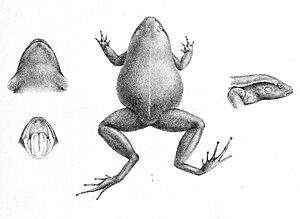Barygenys atra facts for kids
Quick facts for kids Barygenys atra |
|
|---|---|
 |
|
| Conservation status | |
| Scientific classification | |
| Synonyms | |
|
The Barygenys atra is a type of frog that belongs to the Microhylidae family, also known as narrow-mouthed frogs. This frog is special because it is only found in eastern New Guinea. You can find it in the Morobe and Northern Province areas of Papua New Guinea. People sometimes call it Gunther's Papua frog.
Contents
Meet Gunther's Papua Frog
This frog is quite sturdy and has a heavy body. It has a rather small head and a pointed nose. Its back legs are not too long, but just right for hopping.
How Big Are They?
Barygenys atra can grow to be at least 41 mm (1.6 in) long. This measurement is taken from the tip of its nose to the end of its body. That's about the length of a small paperclip!
What Does It Look Like?
The frog's snout is mostly smooth. It doesn't have the strong ridges that some other frogs in its family have. Its eyes are very tiny. You might also notice that its eardrum, called the tympanum, is hard to see. There's a small fold of skin above its eardrum.
Its fingers are short and wide at the bottom, getting narrower towards the tips. Its toes have small, flat pads at the ends. Unlike many frogs, Barygenys atra does not have any webbing between its toes.
Colors of the Frog
When scientists preserve these frogs, they look dark purplish-brown. They often have a thin line running down their back. But when they are alive, they can be reddish-brown with some black spots. The sides of their body are usually very dark gray, almost black.
Where Do They Live?
Barygenys atra lives in forests that are found in lowlands and hills. They prefer areas below 700 m (2,300 ft) in elevation. Scientists are still learning more about the exact places these frogs like to call home.
Froggy Family Life
These frogs have a unique way of growing up. Instead of laying eggs that hatch into tadpoles, their eggs develop directly into tiny froglets. This means there is no free-swimming larval stage, like with many other frogs.
Keeping Them Safe
Currently, scientists don't know of any big dangers to Barygenys atra. However, these frogs are not known to live in any protected areas. This means their habitats are not specifically set aside for their safety.
Images for kids



